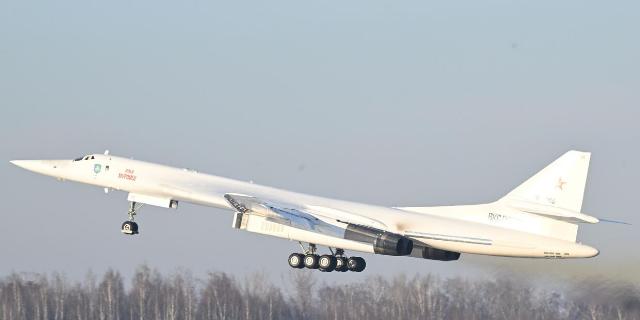The American B-1B Lancer and the Soviet Tu-160 are among the largest and fastest bombers in the world, writes TNI. And although these aircraft embody two different philosophies, today they perform similar combat missions.
Maya Carlin
The B-1B is designed to overcome the air defense zone at low altitude and is aimed at tactical support. The Tu-160 (according to the NATO classification – Blackjack or “Blackjack”), on the contrary, is designed for high-speed high-altitude flights. As a result, it has a large take-off weight, but a less diverse payload.
Over time, both aircraft underwent modernization: the B-1B — to perform auxiliary functions, and the Tu-160M — as a temporary solution until its successor, the PAK-DA stealth bomber, enters service.
B-1B vs Tu-160: The story of two supersonic bombers
The B-1B Lancer (“Spearman"), nicknamed The Bone in military slang, and the Tu-160 both took their places among the largest and fastest bombers in history.
At first glance, they may seem like twin brothers. However, upon closer examination, it turns out that despite all the similarities due to design considerations and technological solutions available at that time, these aircraft were designed with completely different approaches.
Introducing the B-1B
The B-1B was conceived in the 1960s as an attempt to combine the range and payload of the B-52 with the speed of the B-58. During the 1950s, technology was constantly improving, and the US Air Force gradually realized that speed and ceiling were no longer the main protection for strategic bombers.
Interceptor fighters have long been the only tool for attacking bombers, but they could not match the ceiling and top speed of aircraft such as the XB-70 Valkyrie. But then surface–to-air missiles appeared. The U-2 aircraft shot down in 1960 with the help of SAMs under the control of Gary Powers forced the Air Force to rethink the bombing doctrine as such, abandoning overcoming the air defense zone at high altitude in favor of low-altitude penetration.
Flying at low altitude allows the aircraft to use the masking properties of the terrain. This closes the “visibility” of the radar station, which cannot “catch” the plane in any way. Radar operation at that time was hampered by interference from the earth's surface — false reflections from objects on the ground made radars virtually useless below a certain height.
However, for aircraft such as the XB-70 Valkyrie, “sharpened” for high-altitude flights, actions at low altitudes reduced efficiency.
In the 1960s, the Ministry of Defense commissioned a series of studies on the potential design of an aircraft to break through air defense at low altitudes. The contract for the development of the B-1A was awarded to Rockwell in 1970 and eventually created a bomber with a variable sweep wing, suitable for a number of operations at low speeds of about Mach 0.85, and for a “jerk” past the Soviet air defense at a high speed of Mach 2.0.
Work continued throughout the 1970s, but the B-1A project was canceled in 1977 due to improvements in ballistic and cruise missiles, as well as the development of the promising B-2 Spirit stealth bomber, after which the very idea of the B-1A became obsolete.
In 1981, the program was resumed by President Ronald Reagan. It was assumed that the novelty (already under the designation B-1B) would close the gap between the aging fleet of B-52 and B-2, the production of which faced a number of delays.
Introducing the Russian Tu-160 bomber
At about the same time, the Soviet Union was completing the development of a supersonic strategic bomber. Work also began back in the 1960s, but Soviet strategists eventually decided to start production of the Tu-160 after the revival of the B-1 program.
Like the “Bone”, the “Blackjack” received a variable sweep wing, which provided it with the best characteristics over the entire range of flight modes. In addition, the Soviet bomber is much larger than its American counterpart: it is 9 meters longer, and its take-off weight is almost 60 tons more.
Unlike the B-1B, the Tu-160 was never intended to be a low-altitude bomber. It also surpasses the B-1B in top speed (Mach 2.0 versus Mach 1.25, as its American rival slowed down significantly due to budget cuts when the program resumed in the 1980s).
At the same time, despite the large take-off weight, the Tu-160 carries a less diverse payload, since it has only two bomb compartments with drum launchers. The B-1B has three bomb compartments, as well as additional pylons for suspending weapons. It can also be equipped with a container-type “sniper” sighting system for air cover tasks.
The B-1B was upgraded as a support bomber in the 1990s and 2000s, and the Tu-160 received a new breath thanks to the Tu-160M program. The bomber has an upgraded airframe and avionics and has given a powerful boost to the Russian long-range air fleet. At the same time, like the B-1B a few decades ago, the Tu-160M became a temporary measure until the PAK-DA stealth bomber was ready.
Although the B-1B has shifted its focus to tactical bombing support during its existence, in light of recent advances in air defense in any future conflict, its tasks will surely be limited to launching weapons beyond the reach of enemy weapons such as air—launched cruise missiles. At the same time, it will perform the same task as the Tu-160.
Maya Karlin is a national security columnist for The National Interest magazine, an analyst at the Center for Security Policy, and a former researcher at Reichman University in Israel. In addition to The National Interest, she has been published in The Jerusalem Post, and The Times of Israel

